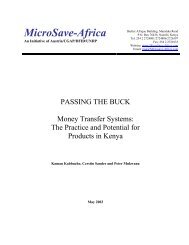You also want an ePaper? Increase the reach of your titles
YUMPU automatically turns print PDFs into web optimized ePapers that Google loves.
70<br />
<strong>of</strong> Party jobs overseas. As long as this was the<br />
case, real authority remained concentrated at<br />
the top <strong>of</strong> the firm.<br />
By the time <strong>of</strong> the CEO transition in 1999,<br />
however, more authority had been devolved to<br />
the operating groups, and their leaders all had<br />
the title <strong>of</strong> Vice President. These were timely<br />
changes, reflecting the lateral diversification<br />
<strong>of</strong> <strong>DAI</strong>’s practice areas through the addition <strong>of</strong><br />
small and microenterprise, banking, public sector<br />
management, and post-conflict stabilization<br />
to its traditional portfolio <strong>of</strong> agriculture-related<br />
services. Barclay gave his full support to the increasingly<br />
powerful group leaders, including Jim<br />
Boomgard in finance and enterprise development,<br />
Michael Morfit in governance, Ed Stains<br />
in environment and water, and Max Goldensohn<br />
in agriculture. “We had the flexibility and independence<br />
and trust <strong>of</strong> Tony to get on with it,”<br />
said Boomgard. “He didn’t try to run the groups<br />
himself.”<br />
In the previous year, <strong>DAI</strong> revenues had reached<br />
$69 million, and they rose by another $8 million<br />
in 1999. But not for the first time, rapid growth<br />
proved to be just as perilous as a slowdown.<br />
For one thing, <strong>DAI</strong>’s coherence as one company<br />
seemed to slip as the groups gained traction<br />
and revenues continued to climb. Some old-line<br />
employees grew discontented, convinced that<br />
the larger company left little room for creativity<br />
in their work. But these problems were more nuanced,<br />
and less threatening, than the prospect<br />
<strong>of</strong> a financial meltdown.<br />
In hindsight, the problem seems very clear:<br />
not only were the old habits <strong>of</strong> a smaller, more<br />
informal company hard to break, but <strong>DAI</strong>’s<br />
financial controls and accounting system seriously<br />
lagged the growth in revenue. A cascading<br />
series <strong>of</strong> staff departures in the finance<br />
<strong>of</strong>fice compounded that problem in 1999,<br />
resulting in a 100 percent turnover rate in this,<br />
then, underappreciated yet critical part <strong>of</strong> the<br />
company. The Congo project and SWIFT task<br />
orders included large amounts <strong>of</strong> grant funds<br />
that generated no pr<strong>of</strong>it for <strong>DAI</strong>, but in any given<br />
month put heavy demands on available cash.<br />
Much <strong>of</strong> <strong>DAI</strong>’s institutional memory vanished<br />
with those staff, and before long expenses<br />
weren’t being tracked, bank accounts weren’t<br />
being reconciled, invoices were going in late,<br />
and <strong>DAI</strong> faced long delays in getting paid. By<br />
January 2000, the resulting cash drain had put<br />
<strong>DAI</strong> out <strong>of</strong> compliance with the covenants on its<br />
credit agreement. SunTrust Bank proved patient<br />
and confident that management would right the<br />
ship, but the first half <strong>of</strong> the new year was full <strong>of</strong><br />
tension and worry.<br />
<strong>DAI</strong> hired a new Chief Financial Officer, Pamela<br />
Little, a veteran <strong>of</strong> several turnarounds, to stop<br />
the bleeding. Little had Barclay’s backing, and<br />
the Board’s, to do whatever that took, and she<br />
applied an authoritarian “I make the rules” style<br />
while putting in countless long hours with her<br />
newly hired staff to fix the problems. Audited<br />
statements for 1999 did not appear until October<br />
2000, and it was only in November that<br />
current-year results were available, showing



